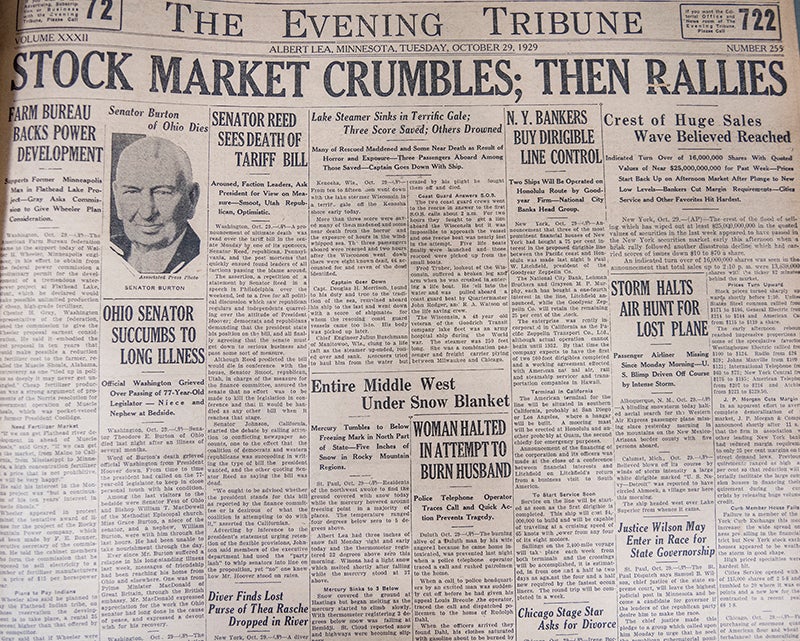This Week in History: Wind turbine section falls off of semi on the way to Manchester
Published 8:19 pm Tuesday, September 15, 2020
|
Getting your Trinity Audio player ready...
|
Local
Sept. 16, 2010: A section of a Vestas wind turbine fell off a semi that was hauling it to the Bent Tree Wind Farm near Manchester. Heavy rain in southern Minnesota saturated gravel roads, contributing to the accident.
Sept. 15, 1990: The Albert Lea High School newspaper, the Ahlahasa, was recognized for excellence by the Association of Education in Journalism and Mass Communications and American Newspapers Publishers Association.
Sept. 19, 1980: The city of Albert Lea received a check for $100,000 from the Farmers Home Administration. The money came as matching funds for the construction of a rail connection from the main rail routes to the city’s industrial park.
Sept. 17, 1970: The Evening Tribune ran the death notice for Marine Lance Corporal James M. Scriver, 19, formerly of Wells. Scriver was killed in action on Sept. 9, 1970, in Vietnam. He served with the 2nd Battalion, 5th Marine Division.
National
2011: A demonstration calling itself Occupy Wall Street began in New York, prompting similar protests around the U.S. and the world.
2005: President George W. Bush took responsibility for the federal government’s mistakes in dealing with Hurricane Katrina and suggested the calamity raised broader questions about the government’s ability to handle both natural disasters and terror attacks.
2001: Two days after the 9/11 terror attacks, the first few jetliners returned to the nation’s skies, but several major airports remained closed and others opened only briefly. President George W. Bush visited injured Pentagon workers and said he would carry the nation’s prayers to New York.
Bush ordered U.S. troops to get ready for war and braced Americans for a long, difficult assault against terrorists to avenge the Sept. 11 attack. Beleaguered Afghans streamed out of Kabul, fearing a U.S. military strike against Taliban rulers harboring Osama bin Laden.
Letters postmarked Trenton, New Jersey, that later tested positive for anthrax were sent to the New York Post and NBC anchorman Tom Brokaw.
1996: Rapper Tupac Shakur died at a Las Vegas hospital six days after he was wounded in a drive-by shooting; he was 25.
1995: The New York Times and The Washington Post published the manifesto of Unabomber Ted Kaczynski, which proved instrumental in identifying and capturing him.
1994: On the 34th day of a strike by players, Acting Baseball Commissioner Bud Selig announced the 1994 season was over.
1986: Federal health officials announced that the experimental drug AZT would be made available to thousands of AIDS patients.
1975: Newspaper heiress Patricia Hearst was captured by the FBI in San Francisco, 19 months after being kidnapped by the Symbionese Liberation Army.
Sept. 16, 1974: President Gerald R. Ford announced a conditional amnesty program for Vietnam war deserters and draft-evaders.
1972: A federal grand jury in Washington indicted seven men in connection with the Watergate break-in.
Sept. 15, 1963: Four Black girls were killed when a bomb went off during Sunday services at the 16th Street Baptist Church in Birmingham, Alabama. (Three Ku Klux Klansmen were eventually convicted for their roles in the blast.)
1962: Mississippi Gov. Ross Barnett rejected the U.S. Supreme Court’s order for the University of Mississippi to admit James Meredith, a Black student, declaring in a televised address, “We will not drink from the cup of genocide.”
1937: The likeness of President Abraham Lincoln’s head was dedicated at Mount Rushmore.
Sept. 14, 1901: President William McKinley died in Buffalo, New York, of gunshot wounds inflicted by an assassin; Vice President Theodore Roosevelt succeeded him.
Sept. 19, 1881: The 20th president of the United States, James A. Garfield, died 2 1/2 months after being shot by Charles Guiteau; Chester Alan Arthur became president.
1814: Francis Scott Key was inspired to write the poem “Defence of Fort McHenry” (later “The Star-Spangled Banner”) after witnessing the American flag flying over the Maryland fort following a night of British naval bombardment during the War of 1812.
1793: President George Washington laid the cornerstone of the U.S. Capitol.
Sept. 17, 1787: The Constitution of the United States was completed and signed by a majority of delegates attending the Constitutional Convention in Philadelphia.





